Art. Law. Crime. Just an artist interested in the wide world of copyright, intellectual property, plagiarism, forgery, and everything in between.
Don't wanna be here? Send us removal request.
Text
Not Rocky, only sucky — A record of the unauthorized use of my photo in Oliver Clegg’s work
This article documents the events surrounding the unauthorized use of one of my photographs in a work by Oliver Clegg, from the initial discovery through to the current situation.
Please consider this a formal report for those who have supported me.
September 7, 2021
I posted a photo of my cat Kofuku and Mr.J.
At the time, someone even made a pixel art version of it, and many people enjoyed it together.
January 2023
A kind follower sent me a mention to a post introducing a “work” by Oliver Clegg.
Clegg later claimed he had tagged my Instagram, but in fact he had created a brand-new tag called “straycatmrj.” This has also been documented.
By that point, someone had already annotated his work via Hypothesis, raising questions about his use of materials.
February 2025
The traced work resurfaced. I began an investigation.
That same month, I consulted a lawyer through an initiative supported by Japan’s Agency for Cultural Affairs:
Bansou.Support – a legal support service for copyright infringement and similar issues on the internet.
I was informed that:
Because the image is viewable online from Japan, this constitutes copyright infringement under Japanese law.
In my case, this use clearly does not fall under fair use.
My rights are protected internationally under the Berne Convention, regardless of the creator residing in the United States.
April 2025
Once again, I saw another traced work posted.
The uploader promptly removed the post and even issued a follow-up to explain the situation. I deeply appreciate their response.
However, the traced image continued to be reblogged.
I decided to follow through on my prior consultation and contact the gallery representing Mr. Clegg.
April 30, 2025 (JST)
I contacted the gallery directly.
A lawyer had advised that “this kind of issue is often treated seriously as a matter of credibility by galleries, so it’s worth contacting them.”
However, I received no response—perhaps because I am merely a Japanese individual blogger.
May 3, 2025 (JST)
I sent a follow-up message, stating that unless I received a response by the close of business on May 6 (EDT), I would make the findings public.
May 7, 2025
With no reply, I published the facts and timeline on Tumblr.
Many people offered support. However, I also witnessed comments that ignored all legal context, and some individuals spread false assumptions and slander.
Such baseless speculation only reveals more about the mindset and behavior of those making it.
I would like to take this opportunity to again express my sincere gratitude to those who responded respectfully and supported me.
May 8, 2025
24 hours later, with more response than expected, I published a follow-up thank-you note in the form of a reblog.
May 9, 2025 (Night)
60 hours later, I discovered that the relevant Tumblr tags were no longer functioning.
I suspected a technical issue—or possibly a report by someone connected to the other party.
I contacted Tumblr Customer Support, and they responded promptly, stating that the issue had been resolved and would be reflected within 24 hours.
Shortly thereafter, the tag search functionality returned to normal.
May 10, 2025
72 hours later: search results had shifted.
Tumblr Search
When searching for the artist’s name, I noticed that the specific work featuring my cat no longer appears in search results.
Google Image Search
The image now appears to be filtered under SafeSearch.
Once again, I would like to express my heartfelt gratitude to everyone who supported and stood with me.
827 notes
·
View notes
Text
0 notes
Text

SO HERE IS THE WHOLE STORY (SO FAR).
I am on my knees begging you to reblog this post and to stop reblogging the original ones I sent out yesterday. This is the complete account with all the most recent info; the other one is just sending people down senselessly panicked avenues that no longer lead anywhere.
IN SHORT
Cliff Weitzman, CEO of Speechify and (aspiring?) voice actor, used AI to scrape thousands of popular, finished works off AO3 to list them on his own for-profit website and in his attached app. He did this without getting any kind of permission from the authors of said work or informing AO3. Obviously.
When fandom at large was made aware of his theft and started pushing back, Weitzman issued a non-apology on the original social media posts—using
his dyslexia;
his intent to implement a tip-system for the plagiarized authors; and
a sudden willingness to take down the work of every author who saw my original social media posts and emailed him individually with a ‘valid’ claim,
as reasons we should allow him to continue monetizing fanwork for his own financial gain.
When we less-than-kindly refused, he took down his ‘apologies’ as well as his website (allegedly—it’s possible that our complaints to his web host, the deluge of emails he received or the unanticipated traffic brought it down, since there wasn’t any sort of official statement made about it), and when it came back up several hours later, all of the work formerly listed in the fan fiction category was no longer there.
THE TAKEAWAYS
1. Cliff Weitzman (aka Ofek Weitzman) is a scumbag with no qualms about taking fanwork without permission, feeding it to AI and monetizing it for his own financial gain;
2. Fandom can really get things done when it wants to, and
3. Our fanworks appear to be hidden, but they’re NOT DELETED from Weitzman’s servers, and independently published, original works are still listed without the authors' permission. We need to hold this man responsible for his theft, keep an eye on both his current and future endeavors, and take action immediately when he crosses the line again.
THE TIMELINE, THE DETAILS, THE SCREENSHOTS (behind the cut)
Sunday night, December 22nd 2024, I noticed an influx in visitors to my fic You & Me & Holiday Wine. When I searched the title online, hoping to find out where they came from, a new listing popped up (third one down, no less):

This listing is still up today, by the way, though now when you follow the link to word-stream, it just brings you to the main site. (Also, to be clear, this was not the cause for the influx of traffic to my fic; word-stream did not link back to the original work anywhere.)
I followed the link to word-stream, where to my horror Y&M&HW was listed in its entirety—though, beyond the first half of the first chapter, behind a paywall—along with a link promising to take me—through an app downloadable on the Apple Store—to an AI-narrated audiobook version. When I searched word-stream itself for my ao3 handle I found both of my multi-chapter fics were listed this way:
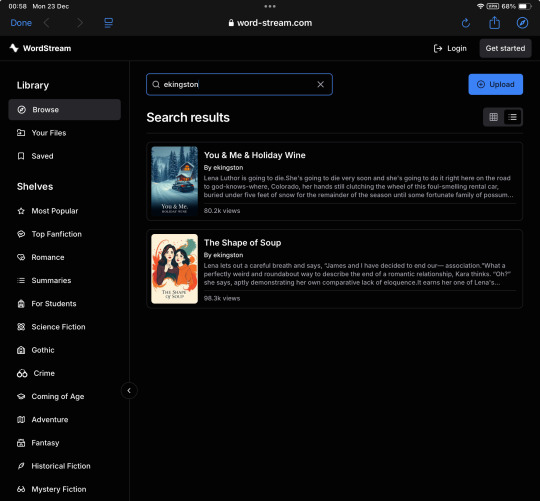
Because the tags on my fics (which included genres* and characters, but never the original IPs**) weren’t working, I put ‘Kara Danvers’ into the search bar and discovered that many more supercorp fics (Supergirl TV fandom, Kara Danvers/Lena Luthor pairing) were listed.

I went looking online for any mention of word-stream and AI plagiarism (the covers—as well as the ridiculously inflated number of reviews and ratings—made it immediately obvious that AI fuckery was involved), but found almost nothing: only one single Reddit post had been made, and it received (at that time) only a handful of upvotes and no advice.
I decided to make a tumblr post to bring the supercorp fandom up to speed about the theft. I draw as well as write for fandom and I’ve only ever had to deal with art theft—which has a clear set of steps to take depending on where said art was reposted—and I was at a loss regarding where to start in this situation.
After my post went up I remembered Project Copy Knight, which is worth commending for the work they’ve done to get fic stolen from AO3 taken down from monetized AI 'audiobook’ YouTube accounts. I reached out to @echoekhi, asking if they’d heard of this site and whether they could advise me on how to get our works taken down.

While waiting for a reply I looked into Copy Knight’s methods and decided to contact OTW’s legal department:
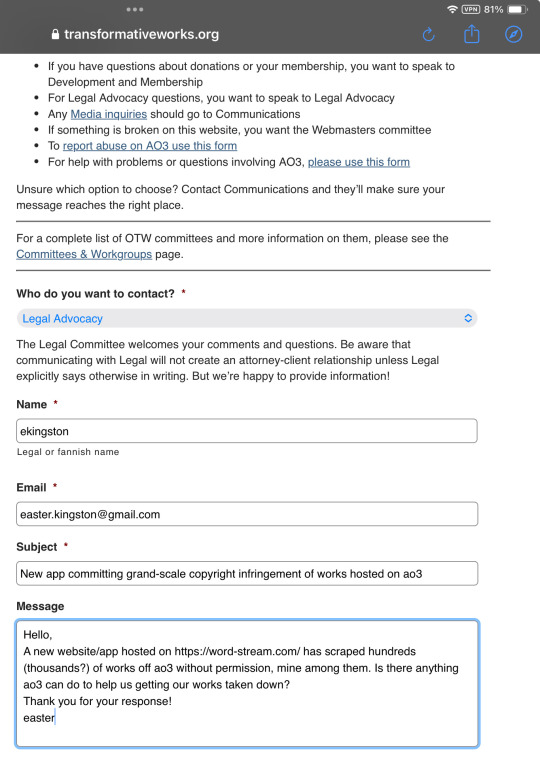
And then I went to bed.
By morning, tumblr friends @makicarn and @fazedlight as well as a very helpful tumblr anon had seen my post and done some very productive sleuthing:

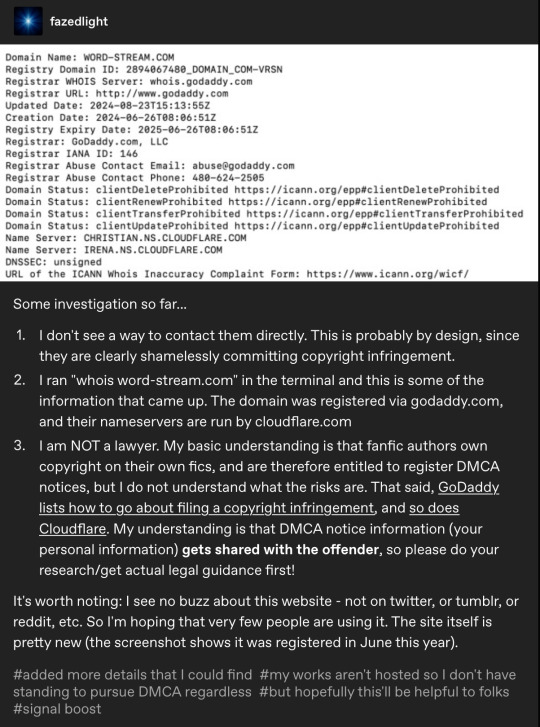
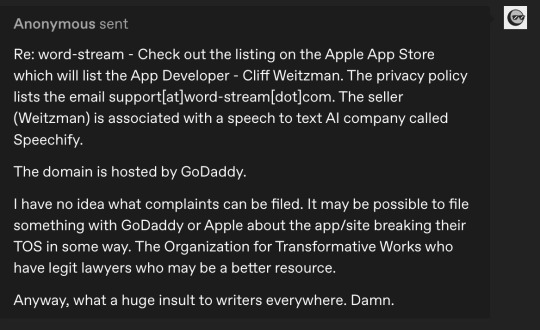
@echoekhi had also gotten back to me, advising me, as expected, to contact the OTW. So I decided to sit tight until I got a response from them.
That response came only an hour or so later:
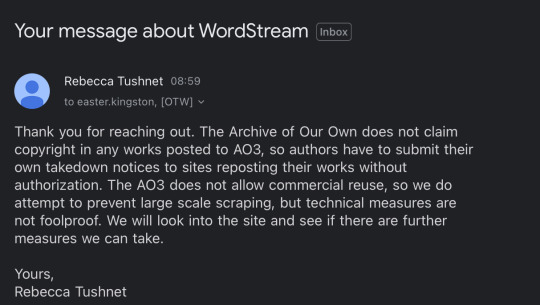
Which was 100% understandable, but still disappointing—I doubted a handful of individual takedown requests would accomplish much, and I wasn’t eager to share my given name and personal information with Cliff Weitzman himself, which is unavoidable if you want to file a DMCA.
I decided to take it to Reddit, hoping it would gain traction in the wider fanfic community, considering so many fandoms were affected. My Reddit posts (with the updates at the bottom as they were emerging) can be found here and here.
A helpful Reddit user posted a guide on how users could go about filing a DMCA against word-stream here (to wobbly-at-best results)
A different helpful Reddit user signed up to access insight into word-streams pricing. Comment is here.

Smells unbelievably scammy, right? In addition to those audacious prices—though in all fairness any amount of money would be audacious considering every work listed is accessible elsewhere for free—my dyscalculia is screaming silently at the sight of that completely unnecessary amount of intentionally obscured numbers.
Speaking of which! As soon as the post on r/AO3—and, as a result, my original tumblr post—began taking off properly, sometime around 1 pm, jumpscare! A notification that a tumblr account named @cliffweitzman had commented on my post, and I got a bit mad about the gist of his message :
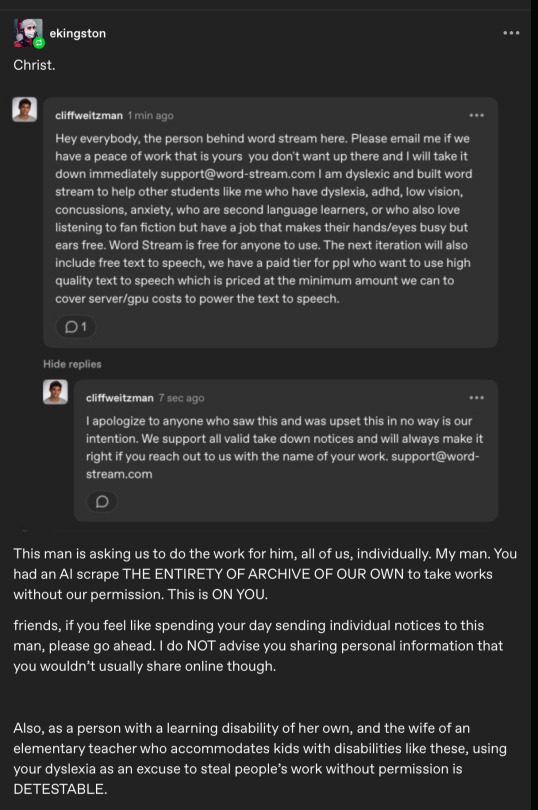
Fortunately he caught plenty of flack in the comments from other users (truly you should check out the comment section, it is extremely gratifying and people are making tremendously good points), in response to which, of course, he first tried to both reiterate and renegotiate his point in a second, longer comment (which I didn’t screenshot in time so I’m sorry for the crappy notification email formatting):

which he then proceeded to also post to Reddit (this is another Reddit user’s screenshot, I didn’t see it at all, the notifications were moving too fast for me to follow by then)
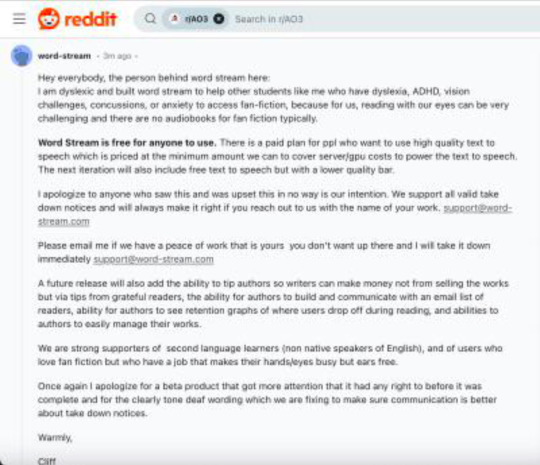
... where he got a roughly equal amount of righteously furious replies. (Check downthread, they're still there, all the way at the bottom.)
After which Cliff went ahead & deleted his messages altogether.
It’s not entirely clear whether his account was suspended by Reddit soon after or whether he deleted it himself, but considering his tumblr account is still intact, I assume it’s the former. He made a handful of sock puppet accounts to play around with for a while, both on Reddit and Tumblr, only one of which I have a screenshot of, but since they all say roughly the same thing, you’re not missing much:

And then word-stream started throwing a DNS error.
That lasted for a good number of hours, which was unfortunately right around the time that a lot of authors first heard about the situation and started asking me individually how to find out whether their work was stolen too. I do not have that information and I am unclear on the perimeters Weitzman set for his AI scraper, so this is all conjecture: it LOOKS like the fics that were lifted had three things in common:
They were completed works;
They had over several thousand kudos on AO3; and
They were written by authors who had actively posted or updated work over the past year.
If anyone knows more about these perimeters or has info that counters my observation, please let me know!
I finally thought to check/alert evil Twitter during this time, and found out that the news was doing the rounds there already. I made a quick thread summarizing everything that had happened just in case. You can find it here.
I went to Bluesky too, where fandom was doing all the heavy lifting for me already, so I just reskeeted, as you do, and carried on.
Sometime in the very early evening, word-stream went back up—but the fan fiction category was nowhere to be seen. Tentative joy and celebration!***
That’s when several users—the ones who had signed up for accounts to gain intel and had accessed their own fics that way—reported that their work could still be accessed through their history. Relevant Reddit post here.
Sooo—
We’re obviously not done. The fanwork that was stolen by Weitzman may be inaccessible through his website right now, but they aren’t actually gone. And the fact that Weitzman wasn’t willing to get rid of them altogether means he still has plans for them.
This was my final edit on my Reddit post before turning off notifications, and it's pretty much where my head will be at for at least the foreseeable future:
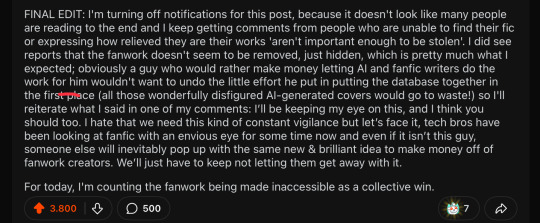
Please feel free to add info in the comments, make your own posts, take whatever action you want to take to protect your work. I only beg you—seriously, I’m on my knees here—to not give up like I saw a handful of people express the urge to do. Keep sharing your creative work and remain vigilant and stay active to make sure we can continue to do so freely. Visit your favorite fics, and the ones you’ve kept in your ‘marked for later’ lists but never made time to read, and leave kudos, leave comments, support your fandom creatives, celebrate podficcers and support AO3. We created this place and it’s our responsibility to keep it alive and thriving for as long as we possibly can.
Also FUCK generative AI. It has NO place in fandom spaces.
THE 'SMALL' PRINT (some of it in all caps):
*Weitzman knew what he was doing and can NOT claim ignorance. One, it’s pretty basic kindergarten stuff that you don’t steal some other kid’s art project and present it as your own only to act surprised when they protest and then tell the victim that they should have told you sooner that they didn’t want their project stolen. And two, he was very careful never to list the IPs these fanworks were based on, so it’s clear he was at least familiar enough with the legalities to not get himself in hot water with corporate lawyers. Fucking over fans, though, he figured he could get away with that.
**A note about the AI that Weitzman used to steal our work: it’s even greasier than it looks at first glance. It’s not just the method he used to lift works off AO3 and then regurgitate onto his own website and app. Looking beyond the untold horrors of his AI-generated cover ‘art’, in many cases these covers attempt to depict something from the fics in question that can’t be gleaned from their summaries alone. In addition, my fics (and I assume the others, as well) were listed with generated genres; tags that did not appear anywhere in or on my fic on AO3 and were sometimes scarily accurate and sometimes way off the mark. I remember You & Me & Holiday Wine had ‘found family’ (100% correct, but not tagged by me as such) and I believe The Shape of Soup was listed as, among others, ‘enemies to friends to lovers’ and ‘love triangle’ (both wildly inaccurate). Even worse, not all the fic listed (as authors on Reddit pointed out) came with their original summaries at all. Often the entire summary was AI-generated. All of these things make it very clear that it was an all-encompassing scrape—not only were our fics stolen, they were also fed word-for-word into the AI Weitzman used and then analyzed to suit Weitzman’s needs. This means our work was literally fed to this AI to basically do with whatever its other users want, including (one assumes) text generation.
***Fan fiction appears to have been made (largely) inaccessible on word-stream at this time, but I’m hearing from several authors that their original, independently published work, which is listed at places like Kindle Unlimited, DOES still appear in word-stream’s search engine. This obviously hurts writers, especially independent ones, who depend on these works for income and, as a rule, don’t have a huge budget or a legal team with oceans of time to fight these battles for them. If you consider yourself an author in the broader sense, beyond merely existing online as a fandom author, beyond concerns that your own work is immediately at risk, DO NOT STOP MAKING NOISE ABOUT THIS.
Again, please, please PLEASE reblog this post instead of the one I sent originally. All the information is here, and it's driving me nuts to see the old ones are still passed around, sending people on wild goose chases.
Thank you all so much.
48K notes
·
View notes
Text
Jordan Studdard infringed upon and adapted my work.
My Instagram:www.instagram.com/woshibaii
My Tiktok:www.tiktok.com/@woshibai_art
276 notes
·
View notes
Text
The Fine Line Between Fan Art, Fan Fiction, and Finding Yourself Sued
This whole article is worth a read for fan creators, especially those of you trying to make an honest buck off your work.
(excerpt below)
How Do You Avoid a Lawsuit? Due to the popularity of fan fiction and fan art, many content owners have begun proactively providing guidelines to their fanbase. Wizards of the Coast (Dungeons & Dragons),[6] CBS and Paramount Pictures (Star Trek),[7] and EPIC Games[8] have all developed policies to inform fans of what they can and cannot do legally. Additionally, usually as long as the fan content is non-commercial, it is not a problem with copyright holders. Regardless, unless the work is completely original, fans should be careful about their creations.
Additionally, try to be smarter than this guy who attempted to sue Amazon for the rights to Lord of the Rings.
438 notes
·
View notes
Text
The Art Forger Had Fooled Thousands. Then He Met Doug.
When a man obsessed with woodblocks began to do business with a man obsessed with medical antiques, their relationship flowered — until it soured.
By Christopher Kuo
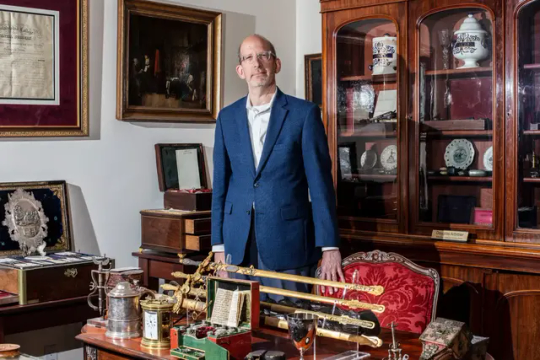
Earl Washington loves wood.
He loves maple wood from Wisconsin and boxwood from Turkey. He loves running his hands on its surface, feeling its heft and texture. But most of all he loves carving it. Thoughts about carving, he says, consume his waking moments.
“If I’m looking at your face when I’m talking to you, I’m literally looking at how I’m going to carve your eyes and carve your nose on a piece of wood,” he said in an interview.
For decades, beginning in the late 1990s, Washington, 62, created thousands of ornate woodblocks and used them to make intricate prints of all kinds of things: biblical imagery, erotica, anatomical illustrations, the stark motifs of German expressionism.
Mastery was never enough for him, though. To profitably sell woodblocks — which can be an oddity in the art market — Washington decided he also needed myth. So he created elaborate origin stories for his pieces. Some, he claimed, had been made or acquired by his great-grandfather. Others he promoted as rare creations from the 16th and 17th centuries.
Thousands of people bought them unquestioningly, but a few became suspicious and raised concerns online and to the authorities. The F.B.I. fielded some complaints, but was not aware, it said later, of the “depth and the breadth” of Washington’s scheme, so he continued to sell his creations, having mastered the craft of carving and the art of fooling others.
Until one day in 2013, when he met Douglas Arbittier.
Everything Earl Washington feels about wood, Arbittier feels about medical antiques.
Arbittier has collected roughly 3,000 medical antiques and runs his own private museum, filled with items like old knives once used for bloodletting and antique surgical sets. His curiosity was stirred in the 10th grade when his mother gave him an old medical chair. Arbittier, a self-described obsessive, quickly decided to track its origins. He rooted around in a library, found the original catalog for such chairs, located the exact model and figured out who made it and how much the chairs had sold for.
“Once the collecting gene fires on, you become obsessed,” he said in an interview.
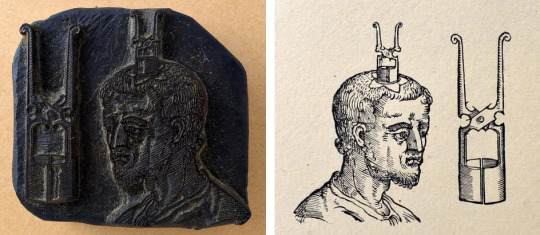
So Arbittier, a 58-year-old doctor and executive for a New Jersey health care system, was intrigued in 2013 when he spotted one of Washington’s woodblock listings on eBay. It depicted an anatomical model of a human thorax and abdomen, and was said to have been created in the 16th century. Arbittier snatched it up.
“Oh my God, I hit the mother lode,” he remembered thinking.
Over the next three years, Arbittier bought 130 woodblocks from “River Seine,” the alias Washington was using, for $118,810. They routinely corresponded, sometimes several times a day, becoming chummy by email.
“The museum,” Arbittier wrote in one, “is eager to have you and your family visit, as am I!”
“River Seine” later wrote back: “I get chills every time I hear how the blocks are appreciated by patrons of the museum.”
Eventually, however, Washington stopped responding, and Arbittier sensed something was off when, for years, his emails went unreturned. Eventually, all of the energy that Arbittier had aimed in other directions was pointed at tracking the identity of “River Seine.”
“Anyone in my family would tell you, I can’t let stuff go,” Arbittier said. “I cannot let something go. It has to be figured out, investigated to death.”

A True Talent for Faux Art
The art of carving wood blocks, or xylography, has been practiced for centuries, though in modern times it occupies something of a niche as an art form. It is believed to have originated in China as one of the earliest forms of printing, but it eventually found its way to Europe in the 14th and 15th centuries.
To create images, one carves the surface of a block of wood so that raised areas can be inked and printed. The recessed areas remain blank.
“In the 15th century, when it was developing, it was the go-to printmaking technique,” said Susan Dackerman, an art historian and an expert on prints and woodblocks. “But now because it’s one of many — and many of the others are digital — the labor involved in cutting is laborious, so only a limited number of artists do it now.”
Washington, who grew up in Detroit, carved for the first time in a high school art contest — on linoleum, not wood. He picked up the craft more seriously in 1987 as a 25-year-old after dropping out of college and ending up in Las Vegas, where he found work at a wood shop.
“Every now and then a person discovers something that is so in tune with everything their mind and brain is designed to do, and that was me when I discovered the woodblocks,” Washington said in an interview.
He began reading everything he could on the topic and made woodblocks on the side while trying his hand at acting and singing in Los Angeles. He created more than 200 blocks featuring images of Hollywood icons. Like some of the people he depicted, many of the creations he made had phony back stories.
Some, he told people, had been created by a great-grandfather — a skilled carver born in 1862, who was apprenticed at a printing shop by the time he was 13. This relative, Washington said, had also amassed his own enormous collection of woodblocks made by others.
None of this was true, of course, but there was money in the lies.
“An artist that is dead is more desirable than an artist that is alive,” Washington said. “It was the only way to do this and with some longevity.”
In 1997, Washington acquired two printing presses, which gave him the ability to turn his carvings into prints. He had given up acting and singing and moved to Michigan, setting up a studio in an old Victorian building with exposed brick and wood floors in Monroe, less than an hour’s drive from Detroit. There, he began acquiring more presses, ranging from lightweight hand-held ones to a hulking eight-foot-tall model built in the 1830s.
From this studio, sometimes working 16 hours a day, Washington churned out block after block, print after print, a factory of craftsmanship that, law enforcement officials say, led to the sale of more than 3,000 blocks and more than a million prints.
The enterprise was upended, though, in 2004, when Forbes published a story titled “Catch Me If You Can.” It posed troubling questions about the authenticity of Washington’s blocks and prints: “Who created the striking woodcuts that crowd the small studio in downtown Monroe, Mich.?”
Several skeptics were quoted, including a former girlfriend of Washington’s and a lawyer, Kenneth Martens, who explained why he had created a website that warned people about Washington’s prints.
“We had people from all over the states thanking me,” Martens, a Canadian, said in a recent interview.
The article said the estate of M.C. Escher, the Dutch artist, had alerted the F.B.I. that phony Eschers were being sold and it reported that an F.B.I. agent in Hawaii had been collecting other complaints about Washington.
Washington said he eventually turned himself in to the bureau’s office in Oahu, where he was questioned for 45 minutes, and then let go. The F.B.I. said it could not confirm the visit.
Scared that people were catching on, Washington largely shut down operations, sold all but one of his presses and moved to Key West, Fla. But he couldn’t stay away from carving for long.
By 2010, Washington was back online, selling blocks and prints under the name “River Seine.” Now he marketed his creations as 16th- and 17th-century artifacts that had been inherited by a relative. He carefully rubbed the blocks of old wood against gravel to erase any new saw marks. He found inspiration online and in books that featured old woodblocks, many of them focused on medical procedures. It was one of those that caught Arbittier’s eye.
A Home for Old Scalpels and Saws
By the time he encountered “River Seine,” Arbittier had been collecting medical antiques for decades. His hobby only intensified during medical school at the University of Pennsylvania and soon his collection boasted all manner of items: candlesticks owned by famous physicians, Civil War surgical sets, amputation saws, leech jars.
When he moved to York, Pa., in 2003, Arbittier’s ambitions grew to the point that, at a cost of approximately $450,000, he built an elegant two-story, private museum behind his home. It included a stained-glass skylight and dozens of glass display cases.
The Arbittier Museum of Medical History drew visits from students, neighbors and officials of other institutions. When the doctor moved recently to New Jersey, he recreated many of the displays in his new home.
“I see myself as a sort of preserver and curator of these things, and I really liked to display them with the stories behind their history,” he said.
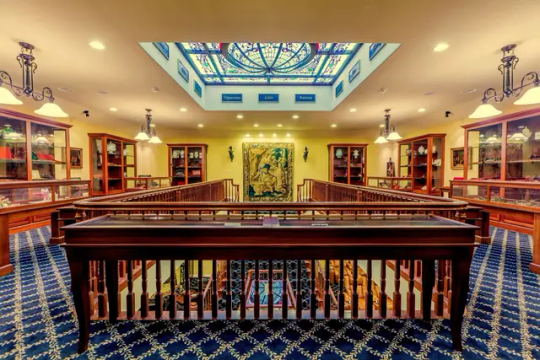
Washington woodblocks, with their intricate details of old, often ghoulishly crude medical practices, were a natural fit for the museum, and over the years that they did business, the men exchanged hundreds of emails.
“I have to tell you honestly that I literally had palpitations as I opened the expertly packed box to find one true treasure after another,” Arbittier wrote in 2013. “I am telling you, River, that this is one of the most important days in my 30 years of collecting.”
Washington later wrote back, as Seine. “It’s a sickness Doug, we share the same symptoms of ‘acquisitive affliction’. BUT I LOVE IT!!!”
“The Arbittier,” Washington continued, referencing the museum, “will be considered the xylographic foundation in the Western World.”
But later, Washington said in a recent interview, his family life began fraying and he lost access to the email account he had been using. Arbittier, unable to reach him for an extended period, thought it was strange that a seemingly legitimate dealer would simply go dark. He began to have niggling doubts about the authenticity of the woodblocks he’d been buying.
Arbittier said he shared his concerns with a German collector, Tilo Hofmann, whom he had introduced to the beauty of River Seine’s woodblocks. Both men found it hard to believe the blocks, each so different and exquisitely carved, could be fake.
But in 2020 Arbittier found a phone number that “River Seine” had given him featured in an online ad for a car being sold by a man named “Earl.” He subscribed to a public records search engine and found the same number came back to an Earl Washington who had lived in Hawaii, Las Vegas and Key West — all places River Seine had lived. And though there were lots of Earl Washingtons online, he discovered that one was the focus of an entire Wikipedia page. It described him as a forger.
“The world comes crashing down at that point,” Arbittier said in an interview. “It was gut wrenching because, oh my God, why did I spend all that money, but also it was a betrayal of the trust and relationship that we had.”
Now, for Arbittier, the real work began.
He culled incriminating content from his years of correspondence with Washington. He gathered his conversations with other collectors. He found and retraced the trail created by others who had suspected Washington earlier than he had. He detailed the steps that had led him to conclude that River Seine was a fraud and sent the whole package to an agent on the F.B.I.’s Art Crime Team.
The attachment was 286 pages long.
“Without this victim coming forward and presenting that initial credible information about his interactions with this individual, we would not have had the opportunity to move to open up an investigation,” Special Agent Jake Archer said. “This victim helped jump-start this investigation, there’s no doubt.”
Hofmann, Arbittier’s collecting colleague, commissioned a carbon-dating analysis of Washington woodblocks that indicated they were not centuries old. Still, it would take years for a team led by Archer and an assistant United States Attorney, Ravi Romel Sharma, to develop enough evidence to bring charges. They did their own carbon study. They tracked others tricked by Washington, at home and abroad. They enlisted German and French authorities to assist. And they arranged for the search of a storage locker in Las Vegas. Inside, investigators found carving tools, blank wood blocks, books on carving and others with images that had served as his source material.
Finally, Washington said, an agent, posing as a buyer, arranged to meet him at a Hawaii hotel. When Washington arrived, Archer approached and flashed his badge. “Take a look,” Archer said he told Washington. “This is real.”
Last summer, Washington and his wife at the time were convicted of conspiracy to commit mail fraud and other charges in connection with the sale of fraudulent artwork to Arbittier, to a collector in Pennsylvania and to two collectors in France. Investigators say their work is ongoing: They are contacting cultural institutions to see if Washington sold them phony woodblocks.
Even the agents who caught Washington still marvel at what he could do with a piece of wood and a sharp tool.
“At one point, he bragged that he was the best in the world at this,” Archer said. “And you know, based on all of our training experience, we had no reason to doubt it.”
After he was charged, Washington continued to email Arbittier. In one note, he offered to carve 100 blocks as restitution.
“I also propose,” he wrote, “to volunteer my xylographic knowledge and services to The Arbittier, bibliographically and otherwise as a docent (volunteer) and contributor to speak at symposiums on behalf of The Arbittier and stage printing sessions to create valuable, unique hand-signed woodblock print keepsakes for Arbittier patrons.”
Arbittier described the offer as beyond belief. “That just showed naïveté or a bizarre behavioral problem or something,” he said. “I’m like, ‘What the hell, man, you defrauded me. Are you kidding me?’”
Washington pleaded guilty and is serving a 52-month sentence at a federal prison in Florida. Though he admits his duplicity, Washington does not think he took complete advantage of people. In a series of telephone conversations from prison, he described himself as a successor to the great carvers of old. He believes that, although his clients did not receive antique woodblocks, his work is art with its own intrinsic value.
Either way, he knows he won’t be making any more carvings for a while, though he said he did find a small piece of wood the other day while walking outside. He tucked it away like treasure.
“I shouldn’t even say this: It’s considered contraband,” he said. “It’s under my bed. I just run my hands over the grain.”
1K notes
·
View notes
Text
YOUR FAVE IS ANTI NATIVE: Temu and Shein

Don't support businesses that steal Indigenous artwork and then mass produce it for pennies. Support Indigenous artists and shops.
1K notes
·
View notes
Text

welp.
Guess we'll be removing the Gilbert Baker 1977 Pride Flag from our site, along with the links to the Gilbert Baker Foundation.
Heads up to other queer artists: if you use the original 1977 flag in anything, definitely don't make any reference to who created it in your listings or you might get threatened by the Gilbert Baker Foundation! :)
9K notes
·
View notes
Text
The sad story of what happened to a married team of creators who lost millions - and their names - to a corporate takeover.
Hold on to those trademarks, kids.

2K notes
·
View notes